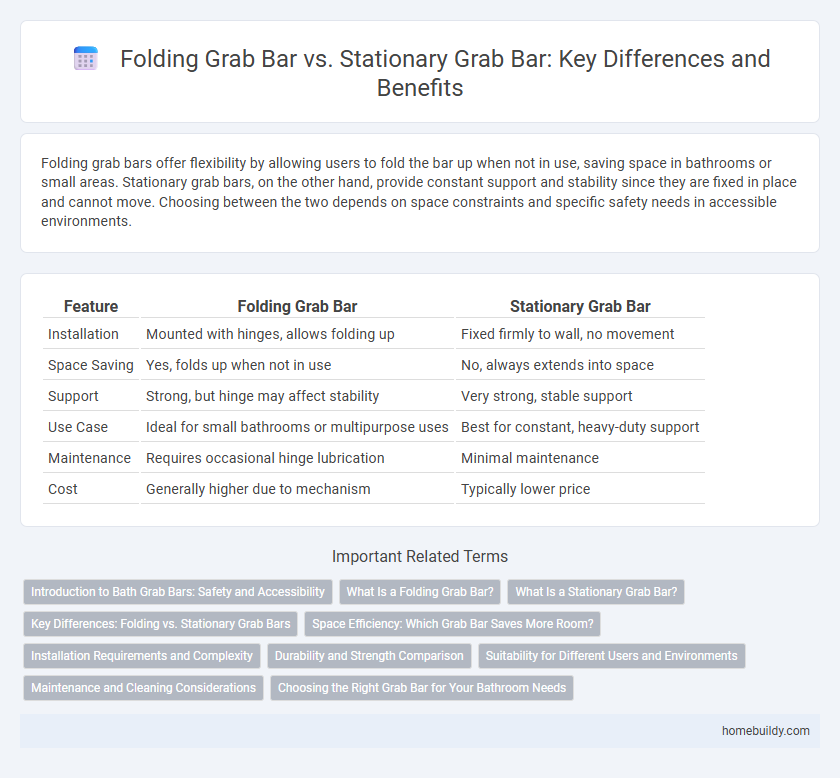Folding grab bars offer flexibility by allowing users to fold the bar up when not in use, saving space in bathrooms or small areas. Stationary grab bars, on the other hand, provide constant support and stability since they are fixed in place and cannot move. Choosing between the two depends on space constraints and specific safety needs in accessible environments.
Table of Comparison
| Feature | Folding Grab Bar | Stationary Grab Bar |
|---|---|---|
| Installation | Mounted with hinges, allows folding up | Fixed firmly to wall, no movement |
| Space Saving | Yes, folds up when not in use | No, always extends into space |
| Support | Strong, but hinge may affect stability | Very strong, stable support |
| Use Case | Ideal for small bathrooms or multipurpose uses | Best for constant, heavy-duty support |
| Maintenance | Requires occasional hinge lubrication | Minimal maintenance |
| Cost | Generally higher due to mechanism | Typically lower price |
Introduction to Bath Grab Bars: Safety and Accessibility
Folding bath grab bars offer versatile support by folding away when not in use, maximizing bathroom space while ensuring safety for individuals with mobility challenges. Stationary grab bars provide constant, robust stability and are ideal for users needing reliable, permanent support to prevent slips and falls. Both types enhance bathroom accessibility, but choosing between folding and stationary depends on space constraints and user preferences for convenience or continuous support.
What Is a Folding Grab Bar?
A folding grab bar is a wall-mounted support device designed to pivot upward or downward, allowing it to be folded against the wall when not in use, maximizing bathroom space. Unlike stationary grab bars, which remain fixed in position, folding grab bars provide versatility for users requiring temporary support while enabling easy clearance for cleaning or mobility. These grab bars are ideal for small bathrooms or areas where space optimization and safety are both critical.
What Is a Stationary Grab Bar?
A stationary grab bar is a fixed safety device securely mounted to the bathroom wall, providing stable support for users during activities such as showering or getting in and out of the bathtub. Unlike folding grab bars that pivot or fold away, stationary grab bars remain in a constant position, ensuring reliability and strength for balance and assistance. These grab bars are typically constructed from durable materials such as stainless steel to withstand moisture and heavy use while meeting ADA compliance standards.
Key Differences: Folding vs. Stationary Grab Bars
Folding grab bars offer space-saving advantages by folding up against the wall when not in use, making them ideal for smaller bathrooms and enhancing accessibility without obstruction. Stationary grab bars provide constant support with a fixed position, ensuring maximum stability and durability for users requiring dependable assistance during bathing. Both types are typically made from corrosion-resistant materials like stainless steel, but choice depends on bathroom layout and user mobility needs.
Space Efficiency: Which Grab Bar Saves More Room?
Folding grab bars save more space compared to stationary grab bars by allowing users to fold the bar up against the wall when not in use, freeing up valuable bathroom area. Stationary grab bars remain fixed, occupying constant space that can limit maneuverability, especially in small or compact bathrooms. This makes folding grab bars the preferred option for maximizing space efficiency in tight bathroom environments.
Installation Requirements and Complexity
Folding grab bars require more complex installation due to the need for secure wall anchors and precise hinge alignment, ensuring safe folding action and load support. Stationary grab bars have simpler installation demands, typically involving direct mounting onto wall studs to provide stable, fixed support. Proper installation of both types must comply with ADA standards to guarantee user safety and durability.
Durability and Strength Comparison
Folding grab bars offer convenience by folding away when not in use but typically feature slightly lower durability due to movable joints and hinges that may wear over time. Stationary grab bars provide superior strength and long-lasting stability as they are fixed securely to the wall with fewer mechanical parts prone to failure. High-grade stainless steel construction in stationary bars ensures reliable support and resistance to corrosion, making them ideal for heavy-duty use compared to most folding models.
Suitability for Different Users and Environments
Folding grab bars offer enhanced versatility, making them ideal for users with limited space or those who require occasional support in bathrooms, such as elderly individuals or people with temporary mobility issues. Stationary grab bars provide a more robust and permanent support solution, preferred in environments where stability and maximum safety are crucial, such as hospitals or homes of individuals with severe mobility impairments. Evaluating the user's physical needs and bathroom layout is essential to determine whether a folding or stationary grab bar will provide the most effective and practical support.
Maintenance and Cleaning Considerations
Folding grab bars require regular hinge lubrication and inspection to ensure smooth operation and prevent rust buildup, while stationary grab bars generally demand less frequent maintenance due to their fixed design. Both types benefit from routine cleaning with non-abrasive disinfectants to eliminate bacteria and maintain hygiene. Stainless steel models offer superior resistance to corrosion and are easier to clean, making them ideal for wet bathroom environments.
Choosing the Right Grab Bar for Your Bathroom Needs
Folding grab bars offer flexibility and space-saving benefits, making them ideal for smaller bathrooms or areas requiring occasional support. Stationary grab bars provide constant stability and strength, suitable for users needing reliable assistance at all times. Selecting the right grab bar depends on bathroom layout, user mobility, and the level of support required for daily activities.
folding grab bar vs stationary grab bar Infographic

 homebuildy.com
homebuildy.com